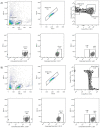Tumor-Infiltrating iNKT Cells Activated through c-Kit/Sca-1 Are Induced by Pentoxifylline, Norcantharidin, and Their Mixtures for Killing Murine Melanoma Cells
- PMID: 37895943
- PMCID: PMC10610189
- DOI: 10.3390/ph16101472
Tumor-Infiltrating iNKT Cells Activated through c-Kit/Sca-1 Are Induced by Pentoxifylline, Norcantharidin, and Their Mixtures for Killing Murine Melanoma Cells
Abstract
The involvement of NK and other cytotoxic cells is considered the first defense line against cancer. However, a significant lack of information prevails on the possible roles played by factors considered characteristic of primitive cells, such as c-kit and Sca-1, in activating these cells, particularly in melanoma models subjected to treatments with substances under investigation, such as the case of norcantharidin. In this study, B16F1 murine melanoma cells were used to induce tumors in DBA/2 mice, estimating the proportions of NK and iNKT cells; the presence of activation (CD107a+) and primitive/activation (c-kit+/Lya6A+) markers and some tumor parameters, such as the presence of mitotic bodies, nuclear factor area, NK and iNKT cell infiltration in the tumor, infiltrated tumor area, and infiltrating lymphocyte count at 10x and 40x in specimens treated with pentoxifylline, norcantharidin, and the combination of both drugs. Possible correlations were estimated with Pearson's correlation analysis. It should be noted that, despite having demonstrated multiple correlations, immaturity/activation markers were related to these cells' activation. At the tumor site, iNKT cells are the ones that exert the cytotoxic potential on tumor cells, but they are confined to specific sites in the tumor. Due to the higher number of interactions of natural killer cells with tumor cells, it is concluded that the most effective treatment was PTX at 60 mg/kg + NCTD at 0.75 mg/kg.
Keywords: CD107a+; Lya6A+; NK; c-kit+; iNKT.
Conflict of interest statement
The authors declare that they have no known competing financial interest or personal relationships that could have appeared to influence the work reported in this manuscript.
Figures








Similar articles
-
An association of iNKT+/CD3+/CD161+ lymphocytes in ovarian cancer tissue with CA125 serum concentration.Immunobiology. 2020 Nov;225(6):152010. doi: 10.1016/j.imbio.2020.152010. Epub 2020 Aug 28. Immunobiology. 2020. PMID: 33130518
-
Antibody-dependent cellular cytotoxicity toward neuroblastoma enhanced by activated invariant natural killer T cells.Cancer Sci. 2016 Mar;107(3):233-41. doi: 10.1111/cas.12882. Epub 2016 Feb 9. Cancer Sci. 2016. PMID: 26749374 Free PMC article.
-
Promotion or Suppression of Murine Intestinal Polyp Development by iNKT Cell Directed Immunotherapy.Front Immunol. 2019 Mar 1;10:352. doi: 10.3389/fimmu.2019.00352. eCollection 2019. Front Immunol. 2019. PMID: 30881361 Free PMC article.
-
Invariant natural killer T cells: front line fighters in the war against pathogenic microbes.Immunogenetics. 2016 Aug;68(8):639-48. doi: 10.1007/s00251-016-0933-y. Epub 2016 Jul 1. Immunogenetics. 2016. PMID: 27368411 Free PMC article. Review.
-
Positive & Negative Roles of Innate Effector Cells in Controlling Cancer Progression.Front Immunol. 2018 Sep 21;9:1990. doi: 10.3389/fimmu.2018.01990. eCollection 2018. Front Immunol. 2018. PMID: 30298063 Free PMC article. Review.
Cited by
-
Evaluation of a Norcantharidin Nanoemulsion Efficacy for Treating B16F1-Induced Melanoma in a Syngeneic Murine Model.Int J Mol Sci. 2025 Jan 30;26(3):1215. doi: 10.3390/ijms26031215. Int J Mol Sci. 2025. PMID: 39940982 Free PMC article.
-
Pentoxifylline and Norcantharidin Synergistically Suppress Melanoma Growth in Mice: A Multi-Modal In Vivo and In Silico Study.Int J Mol Sci. 2025 Aug 4;26(15):7522. doi: 10.3390/ijms26157522. Int J Mol Sci. 2025. PMID: 40806647 Free PMC article.
References
Grants and funding
LinkOut - more resources
Full Text Sources
Research Materials

